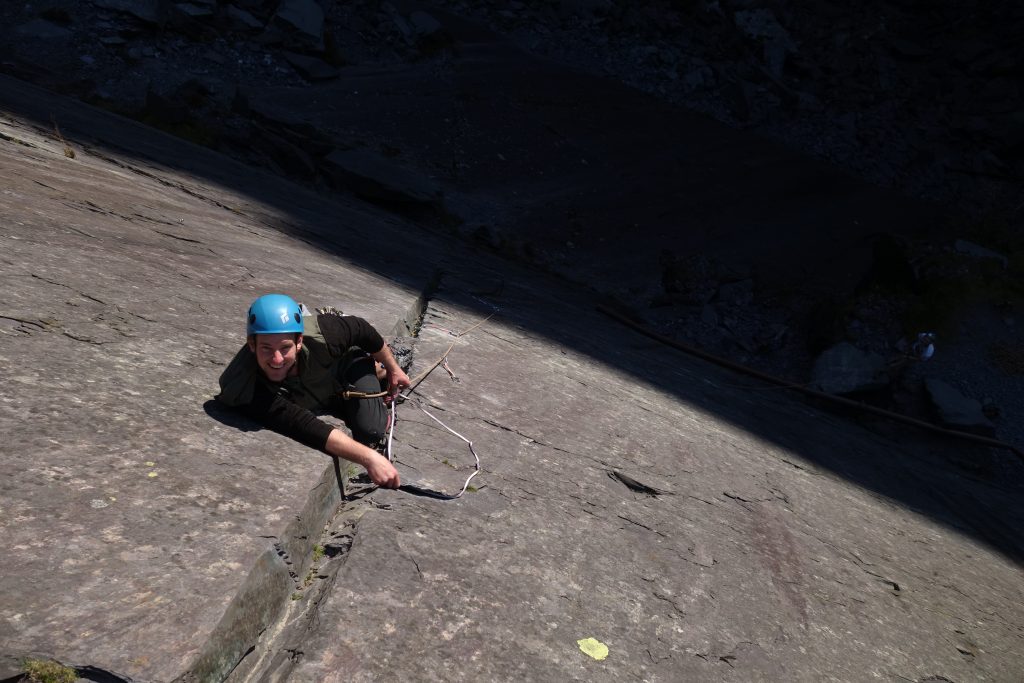THE CRAIG LIST – NORTH WALES CLIMBS FOR THE MIA
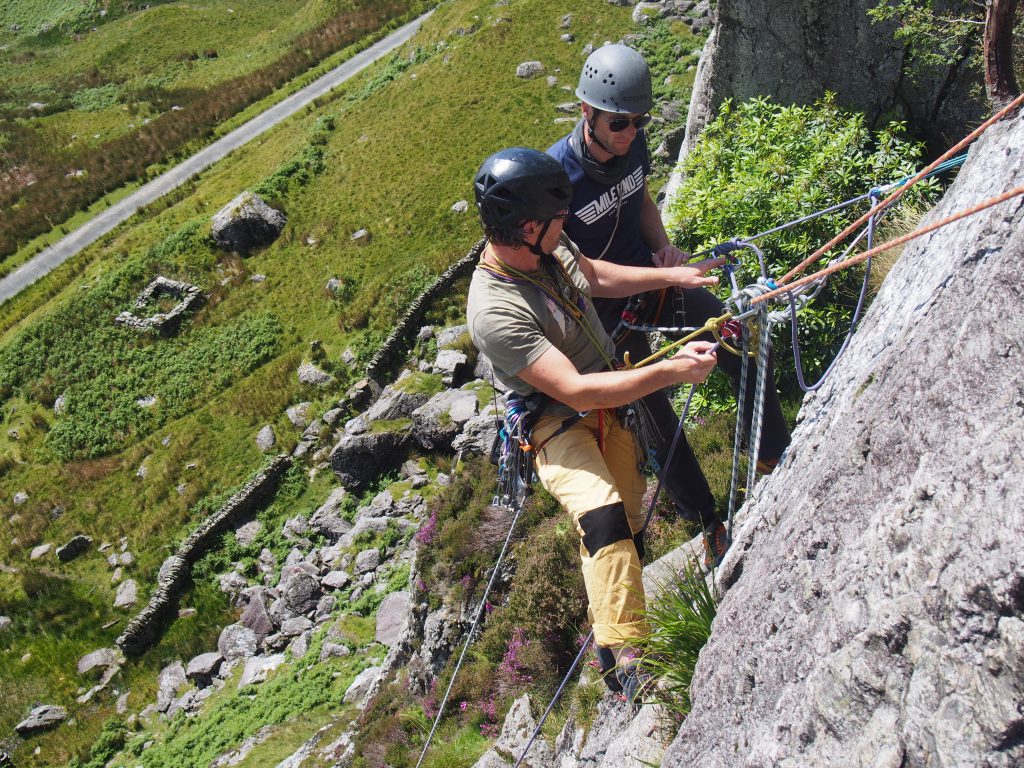
So I was asked by someone aiming to do their MIA assessment in North Wales what routes are good work-routes. Years ago I was handed a list I have long since lost, however I know what routes I use all the time. As such I thought it worthwhile putting a list up to give people a ‘hit list’ for their consolidation and if they are successful their subsequent working life.
PLEASE NOTE THIS IS MY LIST AND MY OPINION, OTHERS MAY HAVE DIFFERENT IDEAS. IT DOES NOT MEAN EITHER THEY OR ME IS WRONG. YOU NEED TO BE ABLE TO JUDGE WHEN A ROUTE IS APPROPRIATE FOR YOUR CLIENT AND WHEN IT IS NOT. AS SUCH THIS IS JUST A LIST OF ROUTES YOU MIGHT POTENTIALLY WANT TO CLIMB OR KNOW ABOUT PRIOR TO YOUR ASSESSMENT OR WHEN YOU ARE WORKING.
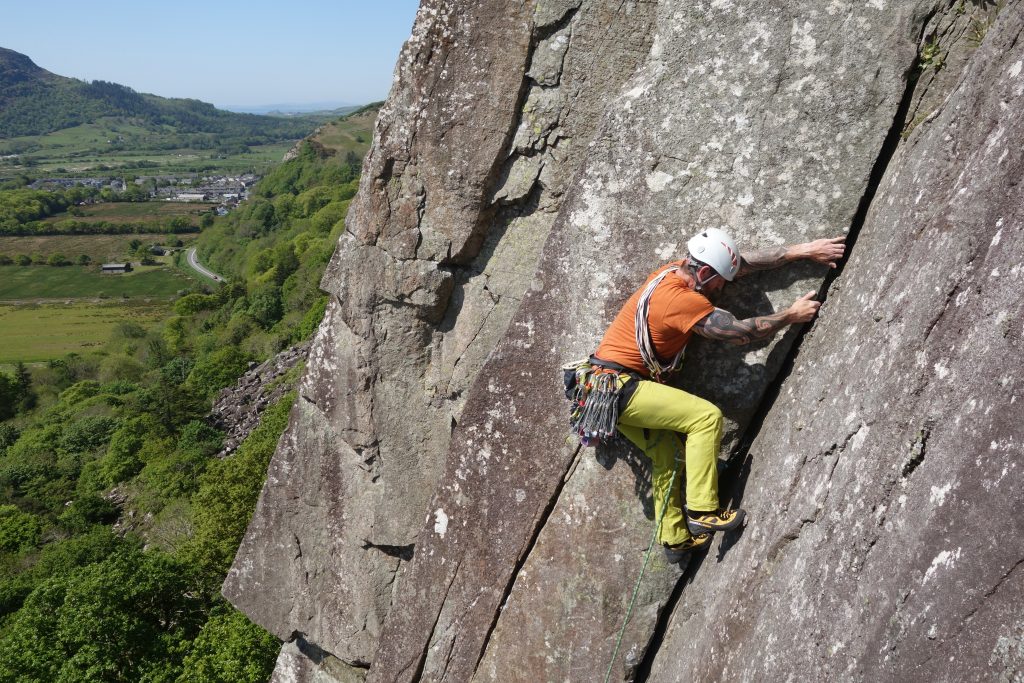
There are several venues worth remembering as well as routes worth having climbed and more importantly thought about how you are going to get you clients down them. So this post is a list of crags and routes that might be worth getting to know before your assessment.
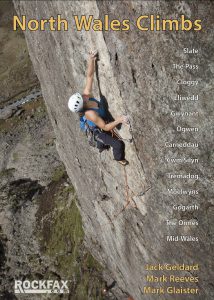
I have had many selective guides books over the years, and whilst all have the majority of these routes in. None had all of them. When I started writing North Wales Climb for Rockfax, the team and I decided to skew the routes towards VS and below grade, and in a way set about making a guidebook that meant I would not need to take any other guidebook with me when I worked. As such if you want a guidebook with all these routes in then visit Rockfax and get your hands on North Wales Climbs.
NOTES ON DESCENTS
Have a plan for every major crag in North Wales. I often have several different plans, one say for clients who I have led up whilst teachings and another for clients who I have supervised and taught leading to on the way up. The first situation I am getting them off the crag safely with a few safety pointer, in the second case I am teaching them how to get themselves off the crag safely.
Both ways usually involved the same exact approach, but in one I am in control and in the system and the other I am controlling and guiding the client’s choices and out of the system. Either way, have a plan. The Idwal slabs and many of the crags in North Wales the crux can arguably be the descent when it comes to client management and safety!
Mentoring and CPD
I offer Mentoring through the MIA scheme, I am one of AMI (The Association of Mountaineering Instructors) mentors on their new mentoring scheme. This list is just part of the resources I offer, along with helping you with your scrambling and teaching. To find out more look at our mentoring scheme.
Climbing Area Info
We also have a list of crags and some great photo in our rock climbing resources section.
LLANBERIS PASS
Generally the climbing here is beyond the absolute beginner save a few routes. It is though a VS+ climbers paradise.
Craig Ddu
A crag that in general takes time to dry, other than Rib and Slab, Yellow Groove.
- Rib and Slab – VDiff – A good route but unless you can find the abseil off, you are faced with a terrifying traverse off the top. Best to take approach shoes up.
- Yellow Groove – VS – A good route with an abseil descent.
- Rift Wall – A good but extremely traditional route with a lot of traversing.
Clogwyn Y Crouchan
A great crag with lots of routes from VS upwards, abseil off all routes rather than top out.
- Phantom Rib – VS – A challenging route, with a thin second pitch and more technical climbing and route finding above. Abseil off.
- Nea – VS – a soft touch for the grade. Good for teaching leading as it follows a corner so clients can get the weight off their arms. Abseil off.
- Spectre – HVS – Something of a sandbag for the modern climber. A great introduction to jamming and has an off-width pitch.
- Sickle – HVS – A very tricky route to manage clients on due to the traversing nature of the route. Can be linked with SS Special as a direct start at about E1.
- Brant Direct – HVS – Very hard but well protected in the main. Again good bridging route.
- Brant – VS – Easy but very traversy hard to protect well with a single rope. Most people only do the first pitch, as descent from the top is horrible and complex.
- Hangover – E1 – No pushover but most of the difficult climbing is fairly inline with the belays. Bold to lead though.
- Kaiserberge Wall – HVS – A great route but a long traversing pitch.
- Karwendal Wall – HVS a harder more direct version of Kaiserberge Wall.
- Wind – HVS – Steep and pumpy HVS climb
Carreg Y Wastad
Another useful cliff for the MIA with two ‘easy’ routes on it. Some routes are best abseiled off others require a careful walk/scramble off the left side of the cliff.
- Skylon – HS – A good route with a short hard section through the low roof to the ledge. Follow by another similar pitch above.
- Wrinkle – VDiff – A long traverse on the first pitch needs protecting to avoid a nasty pendulum. The top pitch is on polygonal columns, some of which are slightly loose.
- Unicorn – HVS – Worth know both the direct and indirect, one requires jamming and is easy if you can, the other doesn’t but is thin.
- Lion – VS – A pleasant if wandering line
- Crackstone Rib – A well worn Severe. Mainly slabby so a good route to teach leading on.
- Ribstone Crack – VS – A good sustained pitch up a crack/groove. Hard middle pitch with two easier pitches either side.
- Shadow Wall – VS – A cracking two pitch route. Abseil off tree (50m).
- Trylon – HVS – A scrappy route with a worrying crux, but knowing as it can help on busy weekends.
Dinas Cromlech
A classic crag, but knowing all the descents and abseil points can make your life easier. Only one or two routes are suitable for beginners though.
- Cobweb Crack – VS – A stiff VS
- Dives/Better Things – HVS – A good Route
- Sabre Cut – VS – A rather tradition off-width groove at the top. Consider taking big gear (cam 5s) or be happy on this terrain.
- Spiral Stairs – VDiff – This has a long but easy traverse if your clients are competent and confident on traverses, otherwise best avoided
- Cenotaph Corner – E1 – A sustain and tricky route.
- Cemetry Gates – E1 – fairly straightforward for the grade.
- Ivy Sepulchre – HVS – Cenotaph Corners little brother, is often free if the other routes are busy.
- Flying Buttress – A really good route which requires a whole gambit of skills to keep you and your clients safe.
Dinas Mot
Generally slabbier, although most of the top pitches are steep and strenuous.
DESCENT NOTES – The two main gullies have two different issues the left as you look at the crag (Eastern Gully) is very loose and clients need to be out of way when someone is abseiling above them or ropes are being pulled. The opposite (Western Gully) is very long and requires two 60m ropes to be able to abseil down it in one pitch
- The Cracks – HS – A great route that ambles about, it has a stopper move on the last pitch though.
- Lorraine and its variations – VS/HVS – Good routes and can be climbed to the terrace where you can abseil off a spike (Not insitu). It is possible for you and not your clients to scramble of the ledge into the gully on the left.
- Direct Route – VS – Classic route with large stances and a very hard move to start the last pitch. Abseil down gully on the left of the crag as you look at it requires care. You can abseil off a thread (not insitu) on the terrace one pitch from the top.
- Diagonal/Super Direct – HVS/E1 – Both have long traverses and best avoided unless the clients are competent.
- West Slab/Western Rib – VS/HVS – Both more or less straight up and good for clients. Can be linked with the spectacular Link or Chain (finger crack on the final pitch)
- Slow Ledge Climb – HS – A great and hidden route, worth doing to give a more continuous mountain day. Descent is tricky as it requires descend Jammed Boulder Gully usually in two abseils or a long walk off.
- Black Slab – HVS – Good if it is dry, rarely ever is.
- Jubilee Climb – HVS – A good route, but with poor stances and some imaginative belays, best avoid with work.
- Plexus, Nexus – HVS/E1 – Both great routes but need very dry weather, they are sustained and demanding. The right hand of the …xus’ has a traverse which is the crux. It is possible to abseil off from an insitu belay just below the top with 60 metre ropes, if you head aim towards llanberis. This is probably best tried with someone who has done it before, or if you see the line someone takes.
- Gardd – HVS – A single pitch to the right of the Plexus buttress that can fill time if people are on the route you desire.
Cryn Las and Parsons Nose
A massive mountain buttress which can be linked to a grade three scramble to give an amazing mountain day.
- Main Wall – HS – a great route, although mainly used for guiding people rather than teaching. A total mountain experience.
OGWEN
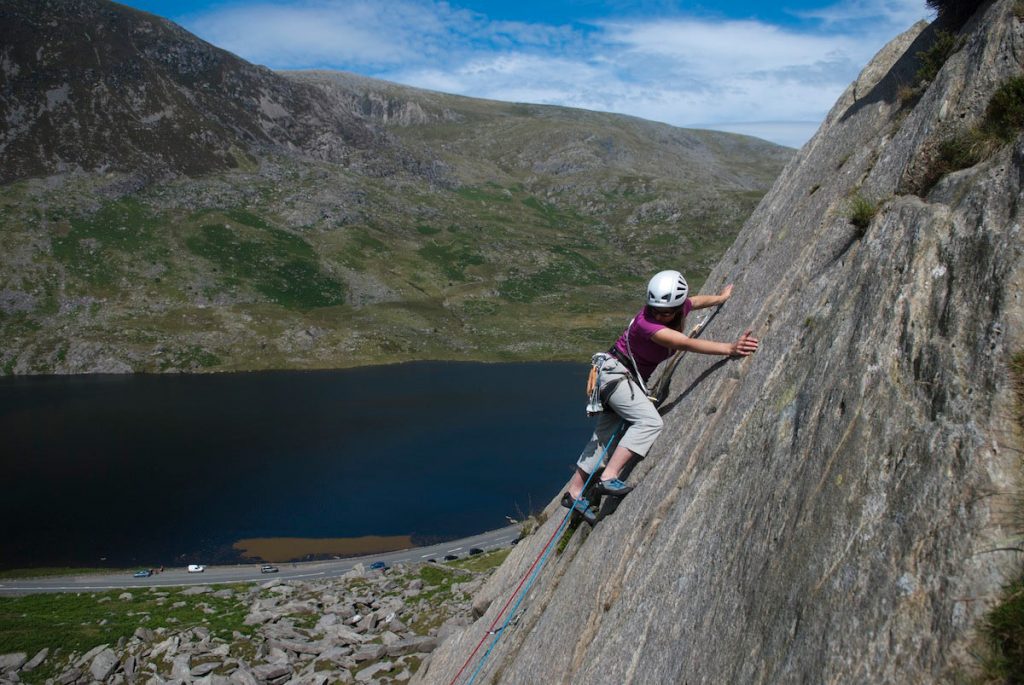
A great valley for novices and many people learnt to climb in this valley. As such it is a firm favourite with intro courses and MIA’s.
Milestone
Again get to know the various descents. You can abseil clients off from the top of Pulpit route and Rowan, just below the Ivy Chimney. You can also scramble off here rightwards into the gully.
- Ordinary Route – Diff – A hidden and often overlooked route compared to Pulpit, Direct route and Rowan route. It also provides a less tradition last pitch than Direct route
- Direct Route – Fabluous polished fun
- Rowan route – Another classic for intro climbing and intro lead as can be broken into many pitches.
- Pulpit – Another classic for intro climbing and intro lead as can be broken into many pitches.
- Ivy Chimney – Vdiff – A great finish to Pulit or Rowan, it does mean you end up at the top and the descent gully needs consideration.
Bochlwyd Buttress
A great crag and quite good for improver courses as there are lots of severes to work on. Generally only one of two pitches. With and easy descent
- Wall climb – HS – Goey for the grade
- Bochlwyd Elinimate – HVS – Again a stady head and quite bold in places
- Two Pitch Route – Severe – A good short multiptich route
- Five Pitch Route – Can you climb it in five ptiches?
- Marble Slab – HS – A real classic.
- Arete and Slab – Diff – A nice easy route up the side
Gribin Facet – Clogwyn Y Tarw
A crag that has plenty of sandbag grades, all of which might have use on a really hot sunny day when you want some shade. It also has it own crack school on the right with Flake Crack and Hereford’s Crack. Again think of climbing some of these.
- recess slab routes – All easy and rather scrappy
- Llyn –
- Zig-Zag – A great HS but needs a brave leader or a large cam
- Flake Crack – Amazing but no for novices but good crack/offwidth chimney shuffling
- Hereford’s Crack – A classic handcrack
Sub-Cniefion Rib
Some instructors love it, I think it avoids the issue of dealing with Idwal Slabs, and will always go to slabs, despite them being harder to manage. It is there for busy days though
Idwal Slabs and Continuation Walls
A fantastic beginners venue. I like many people remember cutting our teeth on this slab and as such it is a popular ‘working venue’ and with teh public. So expect crowds and know how to deal with them.
Know the classics as well as some links between them.
- Tennis Shoe
- Ordinary Route
- Faith
- Hope
- Charity – There is a easy start to Charity and a rather bold and scarey one when it is damp, work out which is which!
- Lazarus – plus at least one other route on this wall (Javelin Buttress, Piton Route, Rampart Corner…)
- Groove above – This has a evil start. Get to know at least one of the other routes on this tier (Staircase, The Arete, Continuation Crack…)
There is also random variations like a HVS solo start to Tennis Shoe, which can be avoided by climbing Ordinary route and traversing across so your clients can follow the direct line. Also there are ways in and around the ribs that divide the slabs. If you are cunning you can sometimes nip around people without getting in their way, if you use smaller belays.
If you climb the continuation walls how easy is it to get off from the ledge above Lazarus or are you best doing a route above that as well?
Craig Yr Isfa
Muir Y Newyl and Pinnacle Wall are great, but getting to the base of the routes are very tricky. I would avoid at all costs Great Gully with clients, and use the approach to Amphitheatre Buttress instead. Again a great route to make a mountain day out of.
MOELWYNS
There are three crags here, most MIA’s seem to use only two. Clogwyn Y Clippiau and Clogwyn Yr Oen, forgetting about Wrysgan. All have good routes, be careful though as some selective guides don’t have all the ‘working routes’ in.
Clogwyn Yr Oen
There are various abseil point all across this crag. Know what length ropes reach the ground from where, as there are several places you can abseil off before reaching the top. Often you can get a route and a half in that way and at the same time cover retrievable abseils.
- Kirkus’ Routes
- Slick
- Chic
- Slack
- Bent
Wrysgan
The routes are a little overgrown and not so good for complete novices.
- Y Gelynen – VDiff
- White Slab/Honeysuckle corner – HS
Craig Y Clipiau
On Clippiau there are routes from Diff to E1.
- Africa rib
- Ashahel – HS plus the eagle finish – VS
- Mean Feet combinations
- Double Chris, which is something of a off width sandbag on the second pitch and requires big cams to make a decent belay.
TREMADOG
Again this is an MIA’s bread and butter. Know the routes and know what they look like from above and below. Know where you can abseil to get to the base of the next route you want to climb without walking down the descent and back up to the base. You can only do this by climbing the classic and using the abseil points and seeing where they land you.
Craig Y Gesail
Very seldom climbed on. Bramble Buttress is the classic VDiff. You can then abseil in to Clutch and its neighbouring routes to avoid the bushwacking first pitches.
Castell
Above the village, this has a few good routes and can be quieter.
- Craig Dhu Wall – HS – A great route care needed to protect clients on traverses. Abseil off check what rope length you need, it might be 60m.
- Tantalus – E1 – A wild traverse on the second pitch requires careful management.
- Mensor – VS – A good route, can be climbed in one pitch if careful with ropes. Abseil off.
Pant Ifan – Upper Tier
Lots of routes here, know them all as finding space for your clients can be tricky on a weekend now, as it is popular with groups and novices alike. Getting to know The Two Faced Buttress and top roping the following routes if the main face is totally rammed can help your day.
- Olympic Slab
- Stromboli
Pant Ifan
There are many classics here worth knowing.
- Scratch VS and Scratch Arete – HVS are very good.
- Poor Man’s Peuterey – Severe – How to divide this up to make the best use of ledges. Feels longer than it is high. You can only abseil off with 60m ropes from the top of Barbarian in one pitch or walk off.
- Great Western – VS – A hidden gem although quite tricky and suffers from stretches of vegetation. It shares ground with PMP.
- Barbarian – E1 – Make sure you have a strong team as this takes no prisoners. A fantastic route though.
There are some route on the Strangeways buttress worth knowing. See NWC.
Blwch Y Moch
Again a firm favourite with MIA’s and climbers due to its location and being owned by the BMC.
- Gilljo – Vdiff – A great route although s sandbag as the first gear is 50ft up it. Best to know it and how to approach it before taking clients there.
- Valerie’s Rib – An OK route although the traverse to the nose can be difficult. Again know the approach.
- Christmas Curry – Severe/HS – Polished by a thousand MIAs. Know both starts and the variations.
- The Plum – E1 – know the easy start!
- The Fang – HVS – Very hard to protect with one rope and two clients, and requires climbing past gear to manage.
- Striptease – VS – This can stay dry briefly whilst a light shower passes. Climb it to the tree and abseil off. There is a higher abseil point that is easily approached from the top. Knowing where this is can help you abseil down to cherry pick the best pitches of Hail Bebe (Vdiff) and One Step in the Clouds (VS)
- Hail Bebe – VD
- One Step in the Clouds – VS
- Grim Wall Direct – HVS/E1 – Can be climb to the half ledge and abseil off.
- Grim Wall – VS – Can be climb to the half ledge and abseil off, very traversy 1st pitch but manageable with care.
- Meshach – HVS – tricky traversing crux, that is hard to manage.
- Shadrach – VS – Know the various ways to start up it and have the crux step off the pillar dialled. Most people avoid the chimney start, but it is well worth experiencing.
- Oakover Area – Know one or two routes here, just in case the crag is really busy.
- Merlin Buttress – There are loads of rotues here and the first can be climbed in various combinations.
- Reinetta, Merlin Direct, Merlin – VS/HVS – Reinetta is a good way to avoid someone stuck on the first pitch of Merlin or Merlin Direct. You can continue up reinetta or knowing where the indirect version of Merlin goes can mean you are not held up by parties on the top crux pitch of Merlin Direct.
- Obleron – Severe – There are many ways to climb the initial slab. Each has pros and cons dependent on whether you are leading or teaching leading. The next pitch is a awkward chimney/roof. From here there are two ways to the top, one up and left to join the top pitch of Merlin the other up the obvious rake to the corner/slot at the top.
- Boo-Boo – You will teach leading on this at some point!
- Rio – HS – a good slab that can be climbed in one or two pitches. Abseil off insitu belay at top.
- Yogi Buttress – Again know Yogi and the routes around it, there are several variations and you can avoid the first by climbing up to the tree just to its left.
GOGARTH AND ANGLESEY
Be wary of coming here, it is very difficult to manage people in this environment unless you know it very well. Sometimes it requires setting abseils where you’d normally scramble down. It can also hlep if two MIA are working the same crag
Rhoscolyn
There are a few routes worth knowing.
- Icarus – HVS – is very trick to teach on as it traverses so much
- Little Queenie Area – E1 – A thin slabs but bold, it is also alarming to get clients to due to the approach.
- The truant – VS – A good route although it is possible at low tide and calm seas to sea level traverse to it can be approach via a very hard to arrange abseil. Again, you need to know where this route is to rig the abseil where the route can be started from a high ledge.
- Fan Fare – HVS – A very steep, very juggy route, best to approach by abseil.
- Symphony Crack – Diff – A stunning route for the grade, well worth seeking out.
- Crag X and Sunset Slab – These area lie either side of the main Rhoscolyn area, both can be used to teach top roping and basic sea cliff climbing skills. Avoid both in big seas and the waves do wash over the top.
The Range and Porth Dafarch
This was overlooked in previous guides, however there are many excellent single pitch sea cliff adventures here. Whilst it is hard to spend a day at one crag, it does mean you get to move about and rig abseils and belays a lot.
- Indedence Slab,
- Botox Zawn,
- Orange Slab,
- South Stack View Zawn,
- D-Day Buttress.
- Fishermans Corner
South Stack – Castell Helen
Castel Helen is the best place here. All the VS/HVS route can work with clients.
- Light House Arete – Know it well and the variations. Can be used to coach lead climbing to experienced climbers looking to make the step into sea cliff climbing. Be warned the abseil is a little over 50m.
- Rap and Pel – Both good routes, although cover similar ground.
- Blanco Area – The HVS around here are similar in style but much more sustain than the VS’s.
Holyhead Mountain
Lots of stuff to do here. It is mosty single pitch but has much better weather than the mountains. It can be busy if it is the only dry crag in the area. If this is the case consider using the Range.
Wen Zawn
A great zawn, but needs careful management to get the clients to the routes. If the tide is out, best to abseil to the boulders below the zawm and hop across to the base. If the clients are competent you can go over the top of the slab and spot them down the descent gully to a abseil point and abseil down the slab. I have only done this with experience clients (i.e. They actually led E2).
- Wen – VS – Be careful of the top
- Concrete Dream – A great combination of Concrete Chimney and the last pitch of Dream. I do this rather than Dream to avoid the traversing problems as this has less sideways climbing, other than along a ledge at the start.
- The last pitch of Dream – It is possible with lots of slings to protect this with one rope. There is a wire just after the step down. I also saw someone fall off this once, from the place you assume they will be left hanging in space they were infact in contact with the rock and easily climbed back up.
- Britomartis – A great HVS, the belay is trick to manage with two clients.
USING THE LIST
This list isn’t a ‘climb all these before you get assessed in North Wales’ list. More important is that perhaps you have been to every crag and are familiar with the approach and descent. Similarly taking time to think about how you can manage clients and what routes are good for teaching which skills. Some routes have lots of one point anchors, whilst others have more complex belays.
I have also left out a few high mountain crags most notably Cloggy, Lliwedd, East Face of Tryfan and Craig Y Ogof in Nantle, the reasons for this is that I prefer to spend my time teaching rather than waisting some of the day driving/walking into and then out of the crags. That is my preference though, I do take clients to these crags, but these are often the rare occassions when the clients just says “give me a brilliant guided day out” or I want to climb “great slab on cloggy..”.
I have also left out the Slate quarries, as there is not much trad for the client, I do use the easy sport climbing a lot to introduce the concept of lead climbing without the difficult of having them place gear.
Finally remember that Snowdonia Mountain Guides lead guide has written several guidebooks to North Wales (North Wales Climb and a new slate guide both by rockfax), he also has written How to Climb harder for Pesda Press and a self published book Effective Coaching. Along with his 12 years of experience teaching multipitch climbing and scrambling, 28 years climbing in North Wales and a Master Degree in Effective Coching Mark Reeves is also mentors people through the MIA scheme. To find out more visit our mentoring page.
